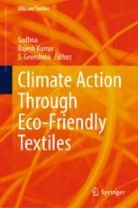
About this book series
The book series “SDGs and Textiles” addresses the strategies to achieve sustainable development goals (SDGs) in the present, past, and future. It presents books about the present and future policies of textile ministries of different countries, and books related to sustainability education around different parts of the world in the textile sector. Moreover, it would welcome the conference proceeding related to SDGs and Textiles. The series would cover books comparing the sustainability and SDGs of different institutions and countries. The individual book volumes in the series are thematic. The goal of each book is to give readers a comprehensive overview of a different area of sustainability in the textile sector. As a collection, the series provides valuable resources to a broad audience in academia, the research community, industry, and anyone looking to expand their knowledge of SDGs and Textiles.
Textiles and life are together – life cannot be separated from textiles as it is the most important need for human beings after food. In 2015, the United Nations General Assembly proposed 17 interlinked global goals to be achieved by 2030. Since then, academia and industry have paid much attention to achieving these goals. Textile found its close relation with almost all of these 17 goals.
SDG 1 - No Poverty: Poverty would never be overcome by a charity only; it is essential to develop people’s skills to have a better and wealthy life. Thus, the textile can be considered an excellent discipline to achieve this goal by creating jobs and small and medium businesses.
SDG 2 - Zero Hunger: Through the effective utilization of advanced application of Agrotech Textiles, it is possible to have higher crop yields and save crops from rough weather, unexpected rains, floods, insects, etc.; thus, geotextiles play an essential in achieving this goal of sustainable development.
SDG 3 - Good Health & well-being: There has been much health consciousness after Covid19, and medical textiles assist in getting good health and well-being.
SDG 4 - Learning & Education: Textile or fashion has remained a significant discipline for societies for ages, and there has always remained much to explore in this field. Textile-related universities may play a vital role by offering free access to their education resources, training and spreading information among the locals.
SDG 5 - Gender Equality: The textile sector is one of the industrial sectors that accepted gender equality long ago; in particular, the garment sector has more females than males. Thus, the textile sector has been doing gender equality. Moreover, there has been a recent trend for Gender Neutral Clothing, which need worth studying and may further assist gender equality.
SDG 6 - Clean Water & Sanitation: Textiles could be achieved through filtration, and of course, textile is one of the critical materials for filtration.
SDG 7 - Affordable & Clean Energy: With the recent advancement in material science and engineering, the textile sector has come on the front for, not only by using this clean energy during textile production but also by assisting the production of this clean energy, either in the form of wind turbines blades made of textile composites or by energy harvesting from T-Shirts, etc.
SDG 8 - Decent Work: Recently, there has been much attention that the textile workers are not paid well, labor rights are not cared about, etc.
SDG 9 – Industry and innovation: Textile Industry always follows innovation; the textile companies that do not chase innovation cannot survive in the market.
SDG 10 - Reduced Inequalities: Getting better life and well-being would help reduce inequalities in the textile industry.
SDG 11 - Sustainable Cities: Sustainable Textile Cities through Buildtech and transport textiles.
SDG 12 - Consumption and Production: Textile and garment consumption and production all come under.
SDG 13 - Climate Action: Oekotech or Ecotech Textile, waste management of textiles are upfront to achieve this goal of sustainable development.
SDG 14 - Life Below Water: Mitigating microfiber waste in rivers and oceans may come under the context of it. There has been much attention on this subject after passing the bill at the parliament level of the UK.
SDG 15 - Life on Land: Geotech or Geotextiles studies life on land.
SDG 16 - Peace, Justice, and Strong Institutions: Protective textiles are doing their best to achieve peace, justice, and strong institutions.
SDG 17 - Partnerships for the Goals: The application of textiles to achieve sustainable development goals is only an example. In all textiles sectors, combined efforts of all the goals are essential to achieve true sustainability.
- Electronic ISSN
- 2948-1244
- Print ISSN
- 2948-1236
- Editor-in-Chief
-
- Hafeezullah Memon
Book titles in this series
-

-
Industry and Innovation: Textile Industry
- Editors:
-
- José Moleiro Martins
- Copyright: 2024
Available Renditions
- Hard cover
- eBook

-
Textiles of Sri Lanka
Sustainable Innovations and Practices
- Editors:
-
- Gayathri Madubhani Ranathunga
- Copyright: 2024
Available Renditions
- Hard cover
- eBook

-
Climate Action Through Eco-Friendly Textiles
- Editors:
-
- Sadhna
- Rajesh Kumar
- S. Greeshma
- Copyright: 2024
Available Renditions
- Hard cover
- eBook

-
Quality Education and International Partnership for Textile and Fashion
Hidden Potentials of East Africa
- Editors:
-
- Xinfeng Yan
- Lihong Chen
- Hafeezullah Memon
- Copyright: 2023
Available Renditions
- Hard cover
- eBook

